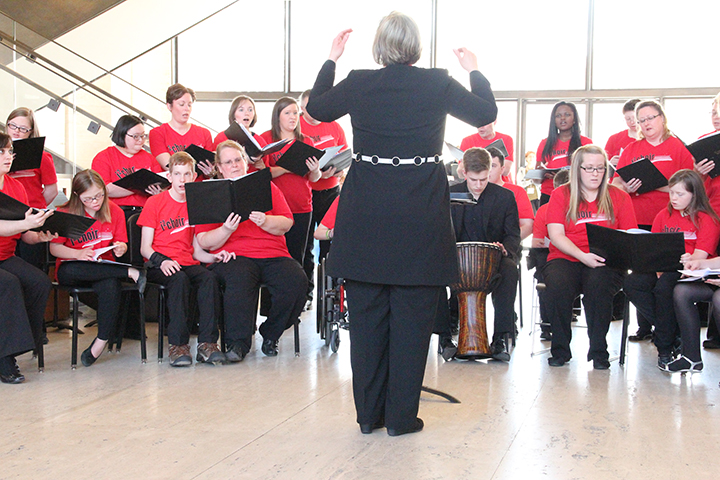
The Glenn Korff School of Music’s i2Choir, under the direction of Associate Professor of Music Education Rhonda Fuelberth, has received a $5,000 grant from the Cooper Foundation.
“I was very excited to hear about the grant,” Fuelberth said. “We have been operating this year on an initial ‘Let’s try this out’ basis with a lot of internal support from the Glenn Korff School of Music, so we’re very pleased to move forward with the kind of support we need to really do the best work for our singers and for the community.”
The i2Choir is an inclusive and intergenerational choral ensemble that has partnered with the Glenn Korff School of Music and the International Quilt Study Center and Museum (IQSCM) to provide music-making opportunities for individuals of all abilities.
The grant will support a pianist, a videographer to document the year, the purchase of music and stipends for undergraduate students in the Glenn Korff School of Music who will become partners in the ensemble, providing support for ensemble members and also receiving valuable training in the process.
Using the principles of Universal Design for Learning, i2Choir singing activities are designed to maximize the learning potential for everyone who participates. Participants this year ranged in age from 5th grade to adults.
“The concept of Universal Design for Learning actually stemmed from universal design in architecture,” Fuelberth said. “So the educational community has learned from this idea of making physical spaces accessible from the start."
The IQSCM, which was designed with that architectural concept, provides staff support and physical spaces for rehearsals and performances.
“Historically, quilt making was an important form of expression and communication for a population whose voices and words were, at one time, diminished by oppression,” Fuelberth said. “Through their artistry, quilt makers were able to not only communicate, but also express themselves through this medium. It is also the intent of the i2Choir to provide a vehicle for communication and expression for underrepresented voices. We are inspired by the beautiful art all around us in the IQSCM.”
It’s also located near the College of Education and Human Sciences’ Barkley Memorial Center, which houses the Department of Special Education and Communication Disorders.
“It’s our hope that we engage in future partnerships with them,” Fuelberth said.
The community choir is open to all participants who can sing, as well as those who want to learn to sing. Participants are encouraged to join in cross-age, cross-ability groups or “singing teams” of two to four who want to participate in the ensemble together.
“We have lots of different pairings and groupings,” Fuelberth said. “We have full families participating, we have singers and friends, we have fathers and sons/daughters, mothers and sons/daughters, and we even have three sisters. The members come with connections to a small group of people, which helps support them initially, and then they broaden those connections to other people in the choir.”
The choir grew from 28 participating in the fall semester to 40 participating last spring.
Since the passing of the Individuals with Disabilities Education Act and its subsequent revisions, and the Americans with Disabilities Act of 1990 and the 2008 ADA Amendments Act, more inclusive practices are being adopted by schools, communities, churches and other civic organizations.
As part of her teaching assignment, Fuelberth teaches an undergraduate course called Music and Special Education, a master’s level course titled Inclusive Music Education and a Ph.D. seminar on Individual Differences and Learning.
“I really wanted an opportunity to step outside of the theory of inclusive music education and have a place where our students can learn and have practical experiences,” Fuelberth said.
The i2Choir project aims to add to the understanding of how individuals with and without special needs benefit from participation in arts experiences, with a particular focus on affective development as a result of participating together.
“My hope is that it continues to expand as a program and becomes a place where we study the use of this Universal Design for Learning framework for music education,” Fuelberth said. “The i2Choir provides a model for that approach, and we will continue to share this work at national and international conferences.”
The i2Choir model will be presented at International Society for Music Education Conferences this summer, as well as at the 2014 Examining the Intersection of Arts Education and Special Education Conference, sponsored by the Kennedy Center’s VSA, the international organization on arts and disability.
Fuelberth has worked with Lynda Laird, a Ph.D. student in music education and Hixson-Lied Fellow in the Glenn Korff School of Music, on the i2Choir project.
“She has been a partner from the beginning,” Fuelberth said. “She drives from Omaha to Lincoln every Sunday and does this over and above her graduate teaching assistantship assignment. She is invested in the concept and will be doing some dissertation research in conjunction with her work with the choir.”
Three area teachers also participate: Jessica Happold, David Woods and Jessica Rajewich.
“They are an invaluable part of the project, singing with the ensemble and assisting with teaching,” Fuelberth said.
The choir performs at least twice a year at the IQSCM and this year also participated in the “At the Threshold” performance at Sheldon Museum of Art in March.
“The i2Choir project is mostly about the process and what happens on Sunday afternoon when we have our rehearsals together, but the performances were really exciting,” Fuelberth said. “Every time the choir sings, we plan to do a community sing. We want the i2Choir to be a part of the community, so that is an important element.”